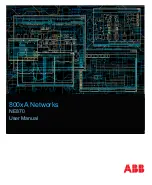
Splitting networks for extended capacities
7.2.2
Example of dissociated network
The following Fig. 22 represents an example of network architecture, using AVM500-ES with some ports dissociated.
Fig. 22: Example of mixed ES100 / ES-V2 network with dissociated ports
FOH is a Yamaha console with two AVY16-ES100 cards. The cards are daisy-chained with port {Ain} of AVM500-ES. This
branch of the network is fully ES100.
Port {B} is connected to a NAI48-ES that is ES100 compatible, and then to two AVY16-ES inside another Yamaha console.
Because of the AVY16-ES, this branch of the network is not fully ES100.
Ports {C} and {D} receive NXAmp 4x4, that are ES100 compatible.
Port {E} receives an AVB32-ES that is only ES-V2.
The goal is to remote control AD8HRs from network 3 with the FOH console, and AD8HRs from network 2 with the Monitor
console. The only way to have multiple tunneling is to dissociate ports of AVM500-ES to create sub-networks with virtual
Primary Master. As AVM500-ES is not PM in this example, we cannot use the dip-switch #1 on the rear-panel. The
dissociation of ports {B} and {E} is done thanks to ES-Monitor software (Fig. 24). List and Tree view from ES-Monitor
software is available Fig. 23. We can clearly see three different networks, as expected.
We can now build a tunneling communication on port {B}, between AVY16-ES and NAI48-ES. Another tunneling (inter-port
tunneling this time) is also build between AVY16-ES100 on port {Ain} and AVB32-ES on port {E}.
In order to control and monitor the entire network, control PC is plugged on port {3
rd
} of the AVM500-ES. Indeed, if this
computer was plugged on the PM of the network, i.e. the AVY16-ES100 in the FOH console, control and monitoring of
network #2 and #3 would have been impossible because of the dissociation.
AVM500-ES User’s Manual v2.1
AuviTran 2010
27
Summary of Contents for AVM500-ES
Page 1: ...AVM500 ES User s Manual 1 ...
















































